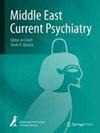Autistic, schizotypal traits, and insight level in patients with obsessive–compulsive disorder
IF 1.6
Q3 PSYCHIATRY
引用次数: 0
Abstract
Comorbid personality disorders and obsessive–compulsive disorder (OCD) range between 33 and 87%. Patients having OCD more commonly receive cluster A (the odd and eccentric cluster) compared with other nonpsychotic patients. Poor insight levels within OCD increase disease severity and impair neuropsychological factors, where OCD patients exhibit poorer speech learning and memory. To assess schizotypal, autistic traits, and insight levels in patients with OCD. Forty subjects with OCD were recruited from outpatient clinics of Kasr Alainy Psychiatry and Addiction Prevention Hospital and assessed using the Dimensional Yale-Brown Obsessive–Compulsive Scale (DYBOCS), Schizotypal Personality Questionnaire-Brief Revised (SPQ-BR), and Autism Spectrum Quotient (AQ) while insight level was assessed using Brown Assessment of Beliefs Scale (BABS). Total DY-BOCS score was positively correlated with the AQ score and SPQ score. Global distress and interference subdomains of DY-BOCS were positively correlated with AQ, SPQ score, and Insight level (BABS). Indicating that the worse the insight the higher the distress and interference in daily life. Global distress and interference were also positively correlated to all subscales of SPQ. Aggressive obsessions were correlated with SPQ score, cognitive-perceptual (CP) traits, ideas of reference, and magical thinking. Contamination/cleaning obsessions were positively correlated with the level of insight (BABS). While sexual and religious obsessions were negatively correlated with the level of insight. Increased severity of OCD is associated with more autistic symptoms, schizotypal symptoms, and poorer insight. No gender differences in OCD patients regarding severity, autistic symptoms, schizotypal symptoms, or insight.强迫症患者的自闭症、分裂型特质和洞察力水平
并发人格障碍和强迫症(OCD)的比例在 33% 到 87% 之间。与其他非精神病患者相比,强迫症患者更常见于A群(古怪和偏心群)。强迫症患者的洞察力较差,会增加疾病的严重程度并损害神经心理学因素,强迫症患者的言语学习和记忆能力较差。评估强迫症患者的精神分裂症、自闭症特征和洞察力水平。研究人员从 Kasr Alainy 精神病与成瘾预防医院的门诊部招募了 40 名强迫症患者,使用耶鲁-布朗强迫症量表(DYBOCS)、分裂型人格问卷简明修订版(SPQ-BR)和自闭症谱系商数(AQ)对其进行评估,并使用布朗信念评估量表(BABS)对其洞察力水平进行评估。DY-BOCS 总分与 AQ 分数和 SPQ 分数呈正相关。DY-BOCS 的总体痛苦和干扰子域与 AQ、SPQ 分数和洞察力水平(BABS)呈正相关。这表明洞察力越差,日常生活中的困扰和干扰就越大。总体痛苦和干扰与 SPQ 的所有分量表也呈正相关。攻击性强迫与 SPQ 分数、认知-感知(CP)特征、参照观念和魔幻思维相关。污染/清洁强迫症与洞察力水平(BABS)呈正相关。性强迫和宗教强迫则与洞察力水平呈负相关。强迫症严重程度的增加与更多的自闭症症状、分裂型症状和更差的洞察力有关。强迫症患者在严重程度、自闭症症状、精神分裂症状或洞察力方面没有性别差异。
本文章由计算机程序翻译,如有差异,请以英文原文为准。
求助全文
约1分钟内获得全文
求助全文
来源期刊

Middle East Current Psychiatry
Medicine-Psychiatry and Mental Health
CiteScore
3.00
自引率
0.00%
发文量
89
审稿时长
9 weeks
 求助内容:
求助内容: 应助结果提醒方式:
应助结果提醒方式:


